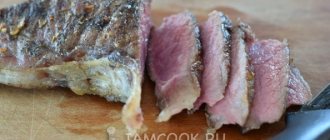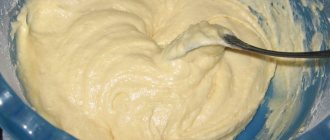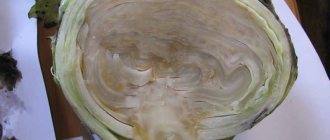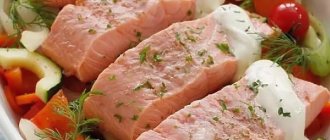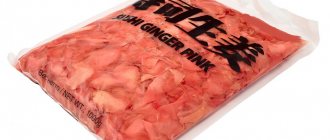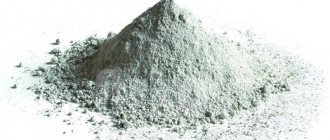Beef is the meat of cattle, which includes bulls and cows of various ages. There is evidence that the first ancestors of modern cattle were domesticated in Transbaikalia about eight thousand years ago.
Beef is classified into second, first and highest grades. The highest grade includes the back and chest parts, as well as fillet, rump, sirloin and rump. The first class includes the shoulder and shoulder parts of the carcass, and the second class includes the shanks, front and back, and the cut. The most valuable meat is considered to be meat from beef cattle. The meat of immature young animals is especially valued.
Beef liver, heart, brains, kidneys and beef tongue are classified as pulpy by-products of the first category. Beef tongue is rightly called a delicacy. It consists of muscle tissue covered by an outer membrane. The tongue can weigh from two hundred grams to two kilograms. This delicacy is carefully processed before reaching the shelves. Lymph nodes, fat and connective tissue are removed.
Chemical composition of beef tongue
Beef tongue is a unique product. It has a number of properties that are necessary and useful to us. In tsarist times, okroshka was always cooked using it. After all, it is a rich source of healthy protein, which also has an excellent taste.
| Calorie content (kcal) | 175 |
| Cholesterol (mg) | 150 |
| Water | 69,0 |
| B(g) | 16,2 |
| F (g) | 12,0 |
| U(g) | 2,3 |
Vitamin-mineral complex:
| Vitamins: | |
| B2 (mg) | 0,32 |
| B5 (mg) | 1,99 |
| B12 (mcg) | 4,75 |
| PP (mg) | 7,6 |
| Macro- and microelements: | |
| Zinc (mg) | 4,85 |
| Chromium (mcg) | 19,2 |
| Molybdenum (µg) | 16,1 |
| Iron (mg) | 4,2 |
| Chlorine (mg) | 250,5 |
| Phosphorus (mg) | 223,3 |
| Potassium (mg) | 254,5 |
Essential amino acids:
| Phenylalanine + Tyrosine (g) | 1,19 |
| Tryptophan (g) | 0,19 |
| Threonine (g) | 0,72 |
| Methionine + Cysteine (g) | 0,65 |
| Lysine (g) | 1,37 |
| Leucine (g) | 1,23 |
| Isoleucine (g) | 0,78 |
| Histidine (g) | 0,61 |
| Valin (g) | 0,86 |
We should probably return to the traditions of our ancestors. After all, there is so much in the sausage that is produced today! A whole set of additives with toxic properties: sodium nitrite, flavorings, flavor enhancers, monosodium glutamate, leather, soy, cartilage! They make okroshka harmful and make it a dangerous product for health. Isn't it better to cook the dish in the old traditional way with beef tongue, the properties of which are undoubtedly beneficial?
Preparation
Any housewife has more than once encountered the concept of meat by-products. For those who are not yet familiar with them, we explain that offal is those parts of the carcass and its internal organs that are of less value than the meat itself. The nutritional value of all by-products is far from equal, due to which they are divided into two categories. For example, a cow's by-products of the 1st category are the tail, liver and kidneys, brains and heart, udder and beef tongue, and the 2nd category includes the stomach, legs and ears.
Usually, various sausages and pates are made from such products; they are good as a filling for pies, pancakes and pies; canned food and semi-finished products are often prepared from offal. But beef tongue is considered a delicacy. It is used to make aspic for the holidays, it is a component of many festive and savory salads, the tongue can be served as an independent snack or used to prepare various cold and hot dishes. Many national cuisines of the world use this delicious offal for their dishes.
Let's talk about language in more detail. What he really is? What are its benefits and harms? How should this product be selected and prepared? What to look for when buying a language?
Beef tongue is the most valued among offal products. It is rich in nutrients and has a delicate, pleasant taste. Its special value lies in its excellent absorption; this by-product even helps to normalize the digestive process.
The tongue is a muscle tissue covered on top with sandpaper with a rough surface. The mass of this organ varies from 0.3 to 2.6 kg (depending on the size of the animal).
If we take the entire language as 100%, then its composition will be as follows:
- 70% water;
- 13% fat;
- 13% proteins;
- 2% carbohydrates;
- 2% – organic extractives (urea, leucine, glutamic acid, taurine, tyrosine, creatinine, inosinic acid, creatine, xanthine).
The offal is a source of a large amount of vitamins (in particular groups E and B), macro- and microelements (copper, iodine, iron, magnesium, phosphorus, chromium, cobalt, zinc, potassium, molybdenum, calcium, manganese, sulfur and sodium).
Beef tongue has two important factors due to which it is classified as a dietary offal: relatively low calorie content (146 kcal per 100 g of product) and low cholesterol levels.
Beneficial features
Much can be said about the beneficial properties of beets , but the main thing is that they do not disappear when cooked. The mineral and vitamin composition and properties that this vegetable possesses do not disappear after heat treatment. Temperature has a detrimental effect on vitamin C, but there is not much of it in beets.
Beets have a beneficial effect on the system and the digestive process. With regular consumption of beets (3-4 times a week), stool normalizes , constipation, bloating and heaviness disappear. Has a mild laxative and diuretic effect. Beets gently cleanse the body of waste and toxins.
Beets normalize blood pressure . Makes capillaries more elastic. Helps with atherosclerosis. This vegetable has antibacterial and anti-inflammatory effects. Helps fight colds and bad mood.
All these properties of beets are explained by its rich composition . Beets contain a large amount of B vitamins, as well as vitamin A and E.
The mineral composition is very diverse; beets contain almost all the elements of the periodic table : iron, zinc, magnesium, potassium, calcium, iodine, selenium, fluorine, copper, phosphorus and many other minerals. Organic acids are present: oxalic, malic and citric.
Beets contain a large amount of fiber . All these substances are not destroyed during cooking, but are stored in the beets.
In the video you will learn about boiled beets, the benefits and harms of them:
Nutritional value and calorie content of beef tongue
The structure of the offal is muscle tissue, covered on top with a dense, rough shell. Weight can reach 2.5 kilograms. Its main valuable properties are its high content of healthy protein, which is also easily digestible. The offal does not contain connective tissue, lymph nodes, or fat. All this is carefully removed before it goes on the counter, since it only causes harm to the human body.
The calorie content of boiled beef tongue per 100 grams is small: only 175 kcal. For its delicate and refined taste and valuable nutritional properties, it is valued by chefs from many countries around the world. Snacks, jellies, salads and other healthy dishes are prepared from the offal.
How to store boiled beef tongue
Before storing boiled beef tongue in the refrigerator, it must be cooled. It can stay there not much longer than fresh - up to 48 hours. You can wrap it in foil or place it in a food container with a tight lid. After cooking, beef tongue will easily absorb foreign odors, which is completely undesirable for its subsequent use.
Don’t forget about the freezer - as one of the ways to store boiled beef tongue after cooking.
After cooking, it is cooled and divided into portions in order to defrost exactly as much as needed each time.
Boiled beef tongue cannot be re-frozen!
See also:
Goose meat is very healthy and dietary. In addition, it stores well. Learn all the intricacies of storing goose meat at home
Raw tongue should not be kept in the refrigerator for more than a day.
When and how best to eat, consumption norms
Of the various methods of preparing this product, boiling is the most commonly used . Boiled beef tongue can be either an independent dish or one of the main ingredients in salads and juliennes.
Read also: How to care for coniferous plants in the country
When stewed, the product also tastes amazing , especially if the braising liquid is red wine or cream.
For frying, breading in the form of crackers or batter is required. There are canned goods, sausages and smoked meats with the addition of the product.
In the dietary menu, beef is always listed as boiled . For maximum benefit, it is advisable to consume boiled beef tongue at least once a week.
Doctors recommend eating beef pulp during a diet, but not more than twice a week. The daily intake of beef tongue is 150 g for a healthy adult.
Useful properties of beef tongue
The value of the by-product is explained by its composition. Due to the rare beneficial compounds in its composition, it is able to restore the chemical balance in the body, which ensures good health and a strong immune system.
Beef tongue is a rich source of healthy, easily digestible protein, which makes it a dietary product. It also contains a significant amount of iron, which ensures the exchange of oxygen between internal organs and the environment. In addition, it contains vitamin B12, a deficiency of which can cause irreparable harm to the hematopoietic system in the human body.
There is zinc, thanks to the properties of which our sex hormones and pituitary gland function fully. There is nicotinic acid (NA), a deficiency of which in the body stops properly synthesizing our main energy substance - ATP, which, accordingly, causes harm to the body: dermatitis, dementia or diarrhea occurs and, as a result, insufficiency of the gastrointestinal mucosa.
Benefits of beef tongue for women
For the better half, the offal will help improve the properties of the skin, maintain a girlish figure and achieve a smooth, calm state of the nervous system, and a restful sleep. Active compounds renew and regenerate skin cells from the inside, preventing them from losing their elasticity and freshness.
Is it possible to eat beef tongue during pregnancy and breastfeeding?
One of the most common problems of expectant mothers is low blood hemoglobin. The problem cannot be ignored, otherwise delay will harm the developing fetus. To quickly increase your red blood cell count, it is enough to introduce beef tongue into your diet, the benefits of which for pregnant women are undeniable. The high content of easily digestible protein and iron will allow you to quickly replenish the missing elements in the blood and provide the developing fetus with nutrition and the required amount of oxygen.
The benefits of boiled beef tongue will be obvious during the postpartum period. However, it should not be immediately introduced into the diet of a nursing mother. This will harm the baby. Substances that get into milk can cause digestive disorders in the baby and the appearance of colic in the abdomen. Therefore, it is better to wait until the baby reaches 3 months of age.
Is it possible to freeze beef tongue: how not to spoil the delicacy
Beef tongue is a product of excellent quality, from which you can prepare a huge number of incredibly tasty dishes. It has been used and valued for many centuries and has always been a favorite delicacy of the ruling elite, right down to the royal families. However, the tongue has one drawback: it can only be stored fresh for a day. Is it possible to freeze beef tongue?
Many owners do not like to freeze meat, especially specific meat, as this harms its taste. And language is such an amazing and respected product that people prefer to treat it even more carefully. Although this is absolutely not necessary - after freezing it practically does not lose its qualities.
The tongue can be stored in this form for weeks: it is very convenient if it is used little by little. Moreover, one beef tongue may not run out for a very long time, especially if there are not very many people in the family.
Moreover, you can freeze beef tongue in boiled form. So it will lose some taste, but it will become very convenient, for example, for quickly preparing delicious salads.
You should remember a few rules that will come in handy when preparing beef tongue for consumption:
- The easiest way to remove the skin is to rinse it with cold water after cooking.
- The delicacy can be cooked either in water or in chicken broth.
- You can check readiness using a fork: the device should easily enter the pulp.
- Fresh tongue is stored for only a day, and boiled - for three days, so if it is not actively used, it is better to freeze it.
- It is best to serve the dish with hot sauce: this way you can emphasize the delicate natural taste of the beef delicacy.
Thus, even if you don’t have time to use the tongue, it won’t go to waste while it’s fresh; the delicacy can delight the whole family for a long time, prepared in a variety of ways. All doubts about whether it is possible to freeze beef tongue can be safely dispelled.
Do you use expired food for cooking at home?
Yes, the main thing is to process it if it is meat or expired kefir for pancakes.
34.62%
No, it is very dangerous and not useful.
24.62%
If the products have fungus or mold, then we throw them away; if they are a couple of days past their expiration date, we use them for food, even without heat or other treatment.
40.77%
Voted: 130
If I freeze sausage, I use it later for pizza or solyanka
At what age can beef tongue be given to a child?
The useful by-product must be gradually introduced into the diet of children. With its valuable properties, it will have a good effect on hematopoietic processes and support the functioning of the nervous system. Dishes made from it will help the child’s body recover from infectious diseases and cure anemia.
Initially, it is recommended that children be given dietary meats (rabbit, veal and others) as complementary foods. Only after the body gets used to the new diet and digestion does not interfere, you can try adding small amounts of beef tongue or liver to the diet. But this should be done no earlier than 8-10 months. Otherwise there will be more harm than good.
How to store beef tongue
Knowing how to preserve beef tongue, you can regularly prepare delicious dishes from it and enjoy them at any time. This versatile and affordable product has an incredibly useful composition. By eating just 100 g of beef tongue daily, you can provide your body with valuable protein and a daily dose of vitamin B12, while consuming only 173 kcal. You can find both prepared and raw beef tongue on sale (their shelf life, of course, is different). Boiled tongue is used for appetizers, fillings for baked goods, hot dishes and salads, and is simply eaten as a snack with bread. More complex dishes are prepared from frozen beef tongue or buy fresh offal. The main thing is to choose a high-quality tongue, because the degree of freshness determines how long beef tongue can be stored in the freezer or refrigerator. It should be elastic, have a pink tint, a pleasant smell and a veterinarian's seal. Now let’s take a closer look at how to properly store it.
Vegetable soup with meatballs
If you want to serve soup with meat, but don’t want to use beef tongue, we offer you the option of a quick vegetable soup with meatballs.
For this beef tongue soup you will need:
- 200-300 g minced meat;
- frozen vegetables: green peas, green beans, broccoli, cauliflower, bell pepper;
- 2-3 potatoes;
- leek;
- salt, pepper to taste.
Roll the minced meat into meatballs, roll in flour and lower into boiling broth. As soon as the meatballs float, throw in the frozen vegetables and diced potatoes. Cook everything until done, stirring slightly so as not to damage the meatballs.
Chop the leek into small chips and masher until the juice releases. When the soup is cooked, pour the onion into the pan and leave everything to brew for 15-20 minutes.
Tip: Make meatballs from minced chicken - the soup will be easier for digestion. To prevent the meatballs from boiling, break a chicken egg into the minced meat.
Is beef tongue good for weight loss?
The benefits of veal tongue and its properties make it possible to include the product in low-calorie diets for weight loss. It contains a small amount of fat and an abundance of easily digestible protein. All this makes it a valuable dietary product. In addition, due to the content of beneficial compounds (B vitamins and others), it improves carbohydrate and fat metabolism.
Dishes made from this by-product tend to satisfy hunger well, which allows you to gradually reduce the amount of food consumed. At the same time, the quality of nutrition does not suffer, and the body is not harmed. Beef tongue contains most of the necessary and beneficial substances.
In addition, the offal contains compounds that improve the functioning of the digestive tract. First of all, its use benefits the gastric mucosa, preventing the development of gastritis - one of the unpleasant consequences of sudden changes in diet.
Attention! When dieting, the benefits of beef tongue will be maximized if it is consumed boiled.
Benefits of beef tongue
It is believed that 100 grams of beef tongue replenishes 9% of the daily calorie requirement. They completely cover a person’s need for vitamin B12 and help normalize fat and carbohydrate metabolic processes.
The body also receives 40% of the required amount of zinc. Beef tongue lowers cholesterol levels. Helps skin regenerate.
Qinu accelerates the healing process of wounds and improves the condition of the skin.
A serving of beef tongue replenishes the supply of vitamin B in the body, which has a beneficial effect on the condition of hair and skin, making it more shiny. The body also receives B vitamins, which protect against migraines and insomnia.
Many diets include beef tongue dishes in their diet. Beef tongue is recommended for weight loss, for children, the elderly, pregnant and nursing mothers.
Beef tongue dishes help with anemia, gastrointestinal problems, and peptic ulcers. There are no connective tissues in the composition, so the fibers are easily digested and absorbed in the body. This is what ensures the absence of putrefaction processes in the intestines and reduces the risk of rectal cancer.
The low level of cholesterol in beef tongue makes the product useful for vascular diseases. It can also remove accumulated cholesterol from the body.
Beef tongue for weight loss can only be consumed boiled without adding spices. After operations, this type of meat helps to recover and get back on your feet in the shortest possible time. The product helps accelerate tissue regeneration and rapid restoration of blood cells.
If you often eat beef tongue, you can improve your health and boost your immunity. Diabetes patients should pay attention to this product. It promotes active insulin production.
For healthy people, eating beef keeps vitamins and minerals levels high.
Beef tongue for pancreatitis and gastritis
The high cholesterol content makes the offal unsuitable for food in case of various diseases, such as pancreatitis and cholecystitis, liver pathology, atherosclerosis.
If gastritis worsens, you should not eat offal, as there is a high risk of harm to the body. But in the remission stage - please. But little by little and in boiled form. Beef tongue is easily digestible and therefore will not overload an inflamed stomach.
Warning! Remember that this delicious delicacy will only be beneficial if consumed in reasonable quantities and in small portions.
How to Store Raw Beef Tongue
It is very important to know how long beef tongue can be stored in one form or another, because this product is for real delicacies.
Before storing fresh beef tongue in the refrigerator, it must be wrapped in cling film, paper or a plastic bag, or better yet, placed in an airtight food container.
No more than 1 day - that’s how long this offal can be stored. You can significantly extend the shelf life of beef tongue by placing it in the freezer.
Up to 8 weeks is how long beef tongue can be stored in an old-style freezer. But in a modern one, with a temperature of 18°C and a No frost system, it can last 6-8 months.
You can first divide it into portions, since you can defrost and cook it several times. In this case, the beef tongue should be wrapped in cling film or placed in a plastic container.
The most important things about storing beef tongue
Raw tongue should not be kept in the refrigerator for more than a day.
Beef tongue will keep in the freezer for 8-10 months.
Boiled tongue must be carefully isolated from foreign odors in the refrigerator.
Harm
Despite all the usefulness of the food product in question, sometimes it can cause harm to human health. Just like the beneficial effects on the body, the negative ones are due to the characteristics of the chemical composition. It is not recommended to eat beef tongue if:
- Individual intolerance.
- Bronchial asthma.
- Diseases of the thyroid gland (for example, Graves' disease or endemic goiter).
- Tendency to allergic reactions.
- Diseases of the digestive system in the acute phase.
- Obesity.
If you have these health problems, you can consume the delicacy for food purposes. Provided that this will be done in limited quantities. Otherwise, there is a risk of deterioration in health. You can also consult a medical professional about the positive and negative effects of beef tongue for an individual.
How and how much to cook beef tongue
To make the offal soft and tasty, it is enough to follow a few simple rules during cooking:
- Soak for an hour. Then scrape well with a knife and rinse with cold running water.
- The product greatly increases in size during cooking. This must be taken into account when choosing a pan.
- After ten minutes of boiling, change the water, draining the first broth. There will be a lot of cholesterol left in it, but the second one can already be used as a base for soup. The benefits of such a dish are much greater.
- Cooking lasts from 2 to 4 hours. The degree of readiness can be easily determined by piercing the tip of the tongue with a fork (knife).
- You need to add salt, pepper and bay leaf at the same time - at the end of cooking.
Directly from the pan, place the hot beef tongue into a container filled with cold water. This will help the skin peel off.
Attention! The benefits of beef tongue broth make it possible to give it to debilitated, seriously ill people. It improves appetite and restores strength.
How to cook beef tongue
It is not difficult to prepare this delicacy if you follow certain rules. First of all, it must be soaked in a large saucepan or bowl of water for half an hour. This must be done so that it can be much easier to clean from dirt. Clean the tongue with a knife, scraping off fat, mucus, dirt and baked blood on the skin surface. Then it must be thoroughly rinsed with cold water. After such preparation, you can boil the beef tongue .
To do this, pour cold water into a large saucepan and lower the entire prepared product into it. If it is large enough, it can be pre-cut in half. The tongue tends to increase in size during cooking. After the water boils, you need to remove the foam, let it cook for fifteen minutes and drain the water.
Wash the pan well, fill it with clean cold water, put in the tongue and let the water boil again. Carefully skim off any foam that has formed and continue cooking over low heat for several hours. will depend on its size, weight, and age of the cow . And you should not confuse it with veal tongue, because they differ in both cooking time and taste.
The beef delicacy takes two to four hours to prepare; salt is added only at the end of cooking, otherwise it will turn out to be harsh. Then you can add peeled carrots, peppercorns and bay leaves to the broth. After two hours of cooking, you can try piercing the tongue with a fork. If cloudy juice flows out, then you need to continue to cook it, and if the juice is clear, you can remove the tongue from the pan and put it in a bowl with cold running water for a couple of minutes.
It’s not enough to know how to cook beef tongue ; you need to properly remove the skin from it, without getting burned yourself or tearing it off in pieces. If the beef tongue is well cooked, then by pouring cold water over it, you can easily remove the skin from it. It is most convenient to store the finished delicacy in the refrigerator in food foil.
Does the housewife need to have any specific knowledge on how to cook beef tongue in order to use it in the future for preparing salads or aspic? There is a small nuance. During the cooking process, the liquid is not salted at all. After removing the skin, the tongue is placed back into the broth in which it was boiled, salted and cooked for another fifteen minutes so that the salt is absorbed into the meat. And such a broth is already better prepared for making aspic.
There is another cooking method, like boiling beef tongue to use it as a cut. In this case, in order to get more juicy and flavorful meat, it should be immersed in hot water rather than cold. After boiling, immediately drain the water, replace it with clean water, heat it and only then lower it into the pan. A tongue cooked in this way will form little foam, will better retain all the juices and will have a softer and more delicate taste.
We recommend reading: How to Make a Horseradish Snack How Much Sugar
There are some small culinary discoveries, so you need to know how to cook beef tongue in order to then use the broth to make soups. Practice has shown that during the cooking process you need to add herbs, aromatic spices, onions, and carrots to the broth whole, without cutting anything. In this case, the liquid will absorb their aroma, which will have a positive effect on the taste of the broth. All herbs and vegetables should be thrown away, and fresh ones should be used to prepare the soup.
Boiled tongue contains a lot of protein and iron, so it is often used as a dietary food for anemia, especially in pregnant women, small children and weakened postoperative patients. Its meat is a dietary light product, healthy and tasty at the same time.
The boiled delicacy is used as slices and is included in salads. Beef tongue is used in jellied dishes; it is used to prepare julienne. Yes, it’s simply very tasty to eat it with horseradish and sour cream sauce and green peas. It is very tasty to eat it with mashed potatoes.
Boiled tongue contains a lot of protein and iron, so it is often used as a dietary food for anemia, especially in pregnant women, small children and weakened postoperative patients. Its meat is a dietary light product, healthy and tasty at the same time.
Beef tongue jellied recipe
First, the offal should be boiled. This process will take a long time, about 4 hours. To ensure that the broth is clean and transparent, the first water (after 15-30 minutes) must be drained. Afterwards, rub your tongue with lemon juice to remove the smell, and put it back into the pan with clean (second) boiling water. Add onions, carrots, and a pinch of salt to make the broth clear.
Remove the finished offal, rinse with cold water and, while it is hot, remove the film. Wait until completely cooled, cut into slices at an angle. Chop the carrots: you can in the form of circles or in the form of flowers or other patterns. You can decorate with parsley, green peas, and a boiled egg cut in half.
Strain the prepared (hot) broth and dissolve the gelatin (300 ml/1 tbsp.). Place the tongue plates and other decorative elements on a dish, pour over and decorate with herbs. Place in the refrigerator.
Attention! It is recommended to store the dish for a day, no more. Otherwise, beef tongue partially loses its best nutritional properties that are beneficial to the body.
How to Store Boiled Tongue
Meat occupies an extremely important place in our diet, since, in addition to proteins and fat, it contains useful mineral salts and vitamins.
It is best to store fresh meat However, there are a number of other ways. Here are some of them: - wipe the meat dry, coat it on all sides with melted pork, beef, or lamb fat, wrap it in parchment paper and hang it in a cool place; - pour boiling water over the meat or lower it into boiling water for a few seconds; - melt the butter in a frying pan, add the meat to fry its top layer on all sides; then pour boiling oil over the meat and store in a cool place; Before eating, such meat is fried as usual; - hold the meat, turning, over a burning gas burner or over another fire until a thin, dry crust forms on its entire surface; then tie the meat with twine and hang it in a draft; - wrap the meat in linen, generously moistened with a solution of strong vinegar, and immediately before use, rinse thoroughly in cold water and cook as usual; such meat should be stored in a closed container or hung in a draft; - cut the meat into large pieces, rub thoroughly with salt, put in a glass or earthenware bowl, close with a lid; meat can also be preserved in a strong salt solution.
We recommend reading: How to Preserve Dry Mushrooms from Moths
Frozen meat, when properly thawed, almost completely retains the nutritional value of fresh meat. To thaw frozen meat, wash it with cold water, place it in a clean container and cover with a lid. It is recommended to cut off only the amount required for the dish from frozen meat, because meat that is first thawed and then frozen again becomes tough, dry and loses its nutritional properties.
Chilled (non-frozen) meat should have a dry crust on the surface, the muscle fibers should be slightly moist but not sticky when cut, the meat juice should be clear, and the smell should be fresh; The pits formed by finger pressure should quickly disappear. All these are signs of good quality meat.
The names of different types of meat and their purpose. For cabbage soup and borscht, beef brisket, rib (intercostal flesh), and hind leg are best suited. For frying, you should take meat from the back (thick edge) and lumbar part (thin edge) and the inner fillet (tenderloin). For stewing, the rump, thigh and hind leg, except the shank, are recommended. Any part of the carcass is suitable for minced meat, with the exception of shanks and brisket. Good minced meat for cutlets and dumplings is obtained from the edge (intercostal pulp). Pork is mainly used for fried and stewed dishes. For soups, it is used much less frequently and is usually used for preparing cabbage soup from sauerkraut, borscht, pea and bean soups. It is advisable to boil, fry or stuff whole lamb and veal brisket.
To make tough meat softer, it must be processed in one of the following ways, having first been cut into thin pieces: put on a wooden board and beat with a special metal or wooden hammer or the blunt side (butt) of a knife; moisten with lemon juice, let it absorb, then fry in a well-heated frying pan; during the stewing process, add 1-2 tablespoons of any dry wine or one tablespoon of table vinegar to the dish with meat; This will make the meat much softer, and the broth will make a delicious sauce; A few hours before cooking (for example, overnight), coat the meat on all sides with mustard, and before cooking, rinse and lightly salt.
The meat broth will be transparent and free from the taste of lard, and therefore more tasty, if you carefully monitor the onset of boiling, open the lid of the pan, allow the foam to collect on the surface and remove it with a slotted spoon, and then periodically remove the fat during the cooking process. To avoid rapid boiling, reduce the heat: the broth should simmer gently, as high boiling may cause it to become cloudy.
To give the broth a golden color, take an onion, cut it crosswise into two parts, place it in a frying pan without fat and fry it well. Then the onion is dipped into the broth and boiled along with the meat. You can fry coarsely chopped carrots for the same purpose.
A strong meat broth is prepared as follows: finely chop the meat, place it in a pan with cold water and slowly heat it to a boil. Cook the meat over low heat, which allows a significant portion of the meat's nutrients to pass into the broth.
To cook meat soup faster, there are two ways: I. Pass raw meat through a meat grinder or prepare meatballs from store-bought minced meat and put them in water instead of a large piece of meat. The soup will be ready in about half an hour. It is recommended to first place the meatballs in a greased frying pan and heat in the oven for 5 minutes - then the soup will be transparent. II. Cut raw meat across the grain into thin long pieces. Due to the fact that more than one large piece will be cooked, it will take 30-40 minutes instead of two hours to make the soup.
Boiled meat will be juicy if you put it in a large piece in boiling water, and then cook it over low heat and with the broth barely simmering.
Boiled meat, as well as poultry, ham, tongue, etc. should be stored in a small amount of broth.
To make cutlets made from lean (lean) meat soft and fluffy, just add a little butter or minced pork lard to the minced meat. You need to fry the cutlets in a well-heated frying pan, and then put them in a hot oven for about five minutes.
Before frying, the brains Change the water several times until the brains are completely clear of blood. Boil water with the addition of vinegar (a tablespoon per 2-3 cups of water), salt and peppercorns. Place the brains in this boiling water, hold for 10-12 minutes, remove the pan from the heat. Then remove, dry, cool and, roll in flour, egg and breadcrumbs, fry in oil in a deep frying pan or in a saucepan. You can fry them either whole or cut into slices. In the latter case, you can do without pre-cooking.
First remove the film from the beef kidneys several waters, cut in half lengthwise, cut out the ureters and internal fat, which can give the kidneys an unpleasant odor. Cut into slices half a centimeter thick and soak in cold water for an hour. Then, after draining the water, put them in a saucepan, add fresh cold water, bring to a boil and drain the broth. After this, the kidneys are washed, again filled with cold water and boiled for 1.5 - 2 hours at low boil.
Fried liver will be more juicy if it is pre-soaked for 2-3 hours in milk, and then carefully monitored so that it does not overcook. Even an extra 1.5 - 2 minutes on the fire can thicken the liver, make it tough and tasteless. To make the film easier to remove, you need to immerse the liver in hot water for a minute. Remove the film carefully so as not to tear the liver, then cut into pieces of equal thickness (so that they heat up more evenly during frying) and roll in flour. Fry in boiling oil until golden brown on one side, then turn the pieces over and fry them on the other side. When turning over, try not to pierce with a fork so that the juice does not leak out. The liver must be salted before the end of frying.
We recommend reading: If You Pick Green Peppers, They Turn Red
Roast lamb will turn out much tastier if you first spread the pieces of meat with mustard and leave it like that for 1.5-2 hours. Before putting the lamb in the pan, scrape off the mustard with a knife. Pork and veal need to be cooked especially well. Lamb and beef are slightly undercooked.
Trying unsuccessfully to cut a piece of meat,
a restaurant visitor calls the official
- Take the entrecote back!
- I can't, sir. You scratched him.
you salt a pork ham . Mix salt with saltpeter and sugar, rub the pork with this mixture and place it in a tub or large pan with the inside facing up. Then the ham is sprinkled with the remaining mixture of saltpeter and sugar and placed in a cold place. After 10-12 days, the salted ham is filled to the top with chilled brine containing cloves, cinnamon, allspice, sugar, and bay leaf. In order for the salt to dissolve better, it is recommended to stir it when pouring the brine. After 15-20 days, the ham is almost ready. It must be hung in a dry, cool, well-ventilated area to dry. The resulting ham is boiled. For 1 kg of pork you need: salt - 100 g, water - 200 g, saltpeter - 7 g, sugar - 10 g, spices - to taste.
Boiled tongue will be soft if you put it in boiling water and cook at low boil for 2-3 hours. After cooking, the tongue should be immersed in cold water and the skin should be immediately removed from it, not allowing it to cool. The broth from boiling the tongue can be used for soup or sauce.
The salting of beef tongues is done as follows. After washing them thoroughly, they are placed in a bowl and filled to the top with brine. After 3-4 days, the tongues are transferred to another container and filled with fresh brine of the same composition as indicated for the ham, at a temperature not exceeding 10°. After 12-18 days, appropriate dishes can be prepared from the tongues.
Rabbit meat is nutritious and easy to digest. Well cooked, it is very tasty. Rabbit can be cooked into a roast or stew, or served as a stew. The rabbit carcass must be pre-processed. Rabbits are usually sold skinned and gutted. If the heart, lungs, liver and neck are left, then they must be removed, and some of the bones of the front and hind legs must be cut off. The carcass is cut crosswise along the last lumbar vertebra into the front and back parts, and then each part is divided into smaller pieces in accordance with the dish that is intended to be prepared.
A strong meat broth is prepared as follows: finely chop the meat, place it in a pan with cold water and slowly heat it to a boil. Cook the meat over low heat, which allows a significant portion of the meat's nutrients to pass into the broth.
Broth with noodles and egg
Prepare for 2-2.5 liters of broth:
- 500 g egg noodles;
- 3-4 boiled eggs (quail or chicken);
- 1 teaspoon of universal soup seasoning;
- two tbsp. spoons of dry mixture of onions and carrots;
- greens, salt, pepper to taste.
Boil the broth, add salt and seasoning and dried vegetables. Discard the noodles and cook until done. Finely chop the greens (you can use dill, parsley, cilantro, green onions).
Pour the broth with noodles into serving bowls, place the boiled egg halves on the noodles, submerging them shallowly in the broth, and sprinkle with herbs.
Add a grinder of black peppercorns to your table setting.
Delicious recipes with boiled beef tongue
Exquisite gourmet meat is used not only as a separate dish for appetizers, but for preparing various aspic dishes.
A simple salad with boiled beef tongue can become a “signature” treat for any housewife.
To prepare you will need:
- boiled beef tongue – 500g;
- boiled potatoes – 300g;
- pickled cucumbers – 2 pcs;
- one apple;
- hard cheese – 50g.
Beef tongue, potatoes, cucumbers must be cut into thin slices. Grate the apple on a coarse grater. Place the prepared foods in a salad bowl. Then add 2 chopped celery stalks, 2 tbsp. spoons of olive oil, 1 tsp. honey, white pepper and salt to taste. Mix everything well, sprinkle grated cheese on top of the salad. Garnish with finely chopped onion.
Beef tongue stew
With ready-boiled tongue, you can quickly prepare a delicious stew, stewed in the oven. To do this, you need to cut 600g of boiled offal into strips, one carrot, 4 pcs. potatoes, onion. All ingredients are placed in layers in a pot, filled with broth in which the tongue was cooked and placed in the oven for 30 minutes. The finished dish is poured into plates and sprinkled with herbs.
Beef tongue appetizer
This light dish is ideal for both holiday and everyday menus.
To prepare you will need:
- boiled beef tongue – 600g;
- mushrooms – 100g;
- sour cream – 1 tbsp. spoon;
- prunes - 2 berries;
- two walnuts;
- onions – 1 pc.
Remove the skin from the boiled tongue and leave it to cool in the broth. Chop the onion, fry in olive oil until transparent, then add boiled mushrooms to the frying, season with sour cream and simmer a little.
Grind prunes with walnuts and mix with mushrooms. Then add black pepper and salt to taste. The tongue is cut into small portions and placed on a plate. The mushroom mixture is laid out on pieces of meat and decorated with parsley or dill. The snack can be eaten both warm and cold.
Delicious tongue pate
Boiled, peeled tongue weighing 700 g is finely crumbled and placed in a mixer cup. Finely chopped eggs (3 pieces), butter (70g), two sprigs of parsley, black pepper, and salt are also placed there. The ingredients are whipped into a homogeneous mass, turning into puree. The finished mixture is transferred to a sealed container and placed in the cold to harden. The pate has a delicate consistency and is served in special molds with green peas or marjoram leaves.
Which tongue is tastier and healthier: beef or pork?
The cost of beef tongue is higher than that of pork tongue. This is explained by the fact that in terms of its taste and nutritional properties it is better and richer, giving the body more benefits. Its delicate, refined taste and unique composition have long identified beef tongue as a delicacy.
Pork offal is somewhat smaller in size. It contains more fat. For those who suffer from extra pounds or diabetes, veal offal will be preferable, because in terms of its performance it is more suitable for low-calorie diets.
Attention! The health benefits of beef tongue are more pronounced than those of pork. People suffering from any diseases should prefer this option.
How to select and store beef tongue
When purchasing a product, you need to pay attention to the following signs indicating its benefits. Beef tongue must be pink (purple) in color, have a good smell, and also have a veterinary mark indicating that it has passed a sanitary examination.
Raw offal can be stored in the refrigerator for about a day, after wrapping it in cling film. After this period, the delicacy must be cooked or placed in the freezer for a longer period. The modern No Frost system allows you to preserve the nutritional properties of the product for up to 8 months or even more; in old-style freezers, this period will be a maximum of 2-3 months.
How to deliciously cook beef tongue so that it is soft and juicy
- Before boiling, defrost the frozen tongue at room temperature until it becomes soft. Then soak the beef tongue in running water for half an hour (to make it easier to rinse). With veal tongue, you can do without soaking, wash it immediately and prepare it for cooking.
- We rinse the tongue with water and a knife to remove mucus and blood, cut off fat and excess meat from the neck.
- Place a large pot of water on the stove and lower the tongue into the pan.
- We wait for the water to boil, reduce the heat to medium, remove the foam and at the first stage cook the tongue for 15 minutes.
- Remove the tongue to a bowl and rinse with cold water.
- Pour the water out of the pan, wash the pan, fill it with fresh water again, and put it on the stove.
- After the water boils in the pan, lightly add salt to it and lower the beef tongue into the boiling water.
- Reduce the heat to low, after the water boils for the second time, cover with a lid (not all the way) and cook the beef tongue for 2.5 to 3.5 hours; Before the end of cooking, add bay leaf to the pan.
- Place the boiled tongue in cold water for 5-10 minutes. We take it out and immediately remove the rough skin on top.
- Boiled beef tongue can be wrapped in food foil and stored in the refrigerator, like boiled pork.
Properly prepared beef tongue is used to make various delicious dishes - aspic, salads with the addition of spicy Korean carrots, canapés.
Advice from the Wonder Chef. The cooking time for the tongue largely depends on how old the animal was. If the tongue is from a young calf, then the cooking time for the tongue is reduced.

